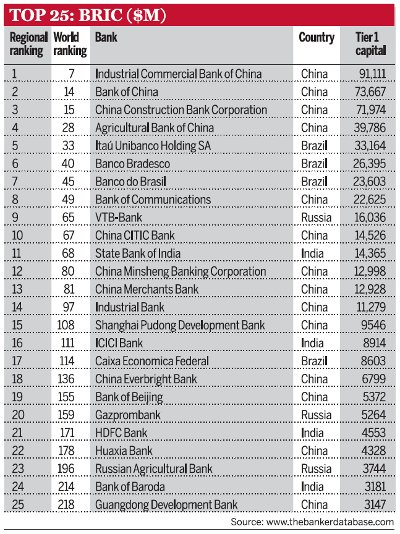China takes a big lead in inaugural BRIC ranking
For the first time in the history of the Top 1000 banks listing, The Banker magazine is providing a ranking of the top 25 banks found in the vibrant BRIC (Brazil, Russia, India and China) economies in order to see how these growing giants fare when measured in terms of their banking system Tier 1 capital.
First, however, what do the buoyant BRIC countries look like in terms of economic performance? Not surprisingly, China is by far the largest economy of the four, with an output of $4909bn for 2009, according to the International Monetary Fund. Next is Brazil at $1574bn, with India third at $1236bn and then Russia at $1229bn. When ranked by projected gross domestic product (GDP) growth for 2010, however, Brazil and India swap places, with China again in the lead with 10% growth for 2010 and India not too far behind with 8.8% growth. Brazil and Russia, meanwhile, trail further behind at 5.5% and 4.25%, respectively.
Together, the top 25 BRIC banks account for a healthy 11% of the aggregate Top 1000 Tier 1 capital but, when ranked according to their contribution to the aggregate top 25 BRIC Tier 1 capital, the BRICs mimic their GDP output rather than their projected GDP growth. Although China is way out in front with a whopping 72% of aggregate Tier 1, followed by Brazil with 17%, India takes third place with 6%, while Russia is well behind with a paltry 5%.
The differential between Asia's two largest economies here is stark, but it is even clearer when viewed in terms of assets. China dominates with a jaw-dropping 79% of the top 25 BRIC bank assets, with Brazil at 13%, India at 5% and Russia at just 2%. China is the only BRIC country whose percentage of the BRIC asset base exceeds its percentage of BRIC Tier 1 capital, although at 7 percentage points, the differential is not yet a cause for major concern.
Few would be surprised to see China in the lead, but the extent of the Asian tiger's dominance - with 72% of Tier 1 capital, 79% of assets and 56% of the ranking by number of institutions - is quite remarkable, and underlines the extent to which bank lending has underpinned the country's incredible economic growth. Contrast this with India: the country's surprisingly poor performance in the top 25 BRIC banks - given its position as the second fastest growing BRIC economy - is rivalled only by its even weaker performance in the top 25 Asian banks. As the adjusted ranking outlined on page 147 shows, India cannot claim to be pushed out of the way by the pre-eminent China. Its banking system is simply underdeveloped relative to its size and growth prospects.
It is also interesting to see that China's dominance of the BRIC ranking is even more pronounced than its dominance of the top 25 Asian banks ranking, where China - up against the highly consolidated Australian market - claims 60% of aggregate Tier 1 capital and 40% of the ranking by number. But what its performance in both rankings seems to confirm is that China's heavy-weights are now only really competing with the developed Western banks - and to a lesser extent the Japanese - for global dominance.
There is one measure, however, by which China does not dominate the top 25 BRIC ranking: average return on assets (ROA). In fact, when ranked by this measure, Brazil takes the lead, with an average 2.55% ROA (excluding Caixa Economica Federal for which there is no data), followed in second place by India, with 1.38%. China in fact ranks third, with 1.09%, and Russia - dragged down by VTB-Bank, which posted a -1.89% ROA for 2009 - comes last at 0.92%.
Despite its dominance of the ranking by number, China does not even meet, let alone exceed, the average ROA for the BRIC top 25 group of 1.3%, suggesting that the country's vast asset base is underperforming compared with that of its BRIC peers.



